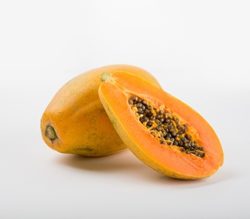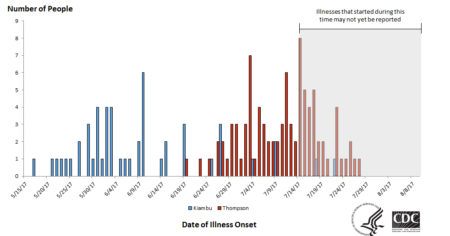The Papaya Salmonella Outbreak Expands as Number of Victims Triples
The Recalls
 Since our last report on July 23, there have been several additional recalls associated with the outbreak of Salmonella in papayas. On July 26 after many people got sick, Grande Produce issued a recall for its imported papayas from the Carica de Campeche farm in Mexico. This farm seems to be the primary source of the outbreak.
Since our last report on July 23, there have been several additional recalls associated with the outbreak of Salmonella in papayas. On July 26 after many people got sick, Grande Produce issued a recall for its imported papayas from the Carica de Campeche farm in Mexico. This farm seems to be the primary source of the outbreak.
On August 4, a second papaya recall was issued by Agroson’s LLC, for more than 2,000 boxes of Cavi-brand Maradol Papaya imported from the same Mexican farm. A few days later, a third papaya recall was issued by Freshtex Produce. These papayas sold under the Valery brand were distributed in Illinois.
Carica de Campeche farm produced papayas under the following brands: Caribeña, Cavi, and Valery.
The FDA first recalled the Maradol papayas from the Carica de Campeche farm in Mexico.
Carica de Campeche farm under the brand Caribeña: This first recall came after extensive testing and trace back. Papayas from the Carica de Campeche farm tested positive for Salmonella Kiambu, Salmonella Thompson, Salmonella Agona, Salmonella Senftenberg, and Salmonella Gaminara. The Caribeña brand was distributed by Grande Produce between July 10 and 19, 2017.
Cavi brand papayas distributed by Agroson’s: Agroson’s LLC, recalled certain Maradol Papaya Cavi Brand, grown and packed by Carica de Campeche. The papayas were distributed on July 16-19 and were available to consumers until July 31.No illness has been reported due to the Maradol Papaya Cavi Brand, and the recall was voluntary in cooperation with the FDA.
Valery brand distributed by Freshtex: The FDA announced that Freshtex Produce of Alamo, TX was voluntarily recalling “Valery” brand Maradol Papayas grown and packed by Carica de Campeche. The papayas were distributed to the State of Illinois from July 10 to July 13, 2017. No illness has been reported.
The FDA increased its testing to see if papayas from other farms from Mexico could be contaminated. More brands and distributors are expected to be linked to the investigation.
The Outbreak
 The CDC found that as of August 9 a total of 141 people were infected with the outbreak strains of Salmonella Kiambu (51) or Salmonella Thompson (90) in 19 states. Among 103 people with available information, 45 (44%) have been hospitalized.
The CDC found that as of August 9 a total of 141 people were infected with the outbreak strains of Salmonella Kiambu (51) or Salmonella Thompson (90) in 19 states. Among 103 people with available information, 45 (44%) have been hospitalized.
The data from the testing laboratory and from epidemiological investigation indicated that the most likely source of the outbreak was Maradol papayas from Carica de Campeche farm in Mexico.
Why did it Happen?
Papayas from Mexico are being screened at the border for Salmonella since the outbreak in 2011, by a third party laboratory. Only papayas that have tested negative for Salmonella are allowed into the USA. The question needs to be asked: how was it possible that the contaminated papayas were able to get into the USA?
As shown in our recent post, research indicated that bacteria can attach and colonize on the surfaces of plants, ultimately forming biofilms. Bassam A. Annous 2005 shows Salmonella produces fimbriae and cellulose, commencing biofilm formation, which helps Salmonella attach and colonize on melon and cantaloupe surfaces. Once attached the cells survive better on the surface.
As mentioned in our previous post, the outbreaks can be due to the ability of Salmonella to attach or internalize into fruits. Survival and multiplication of Salmonella on fresh fruits is considerably increasing once the protective epidermal barrier has been broken. FSMA is designed to help minimize the risk of illness from foodborne pathogens in fresh fruits, and include requirements for water quality, employee hygiene, and equipment and tool sanitation. However, to date, all these new measures did not prevent the current papaya outbreak.
